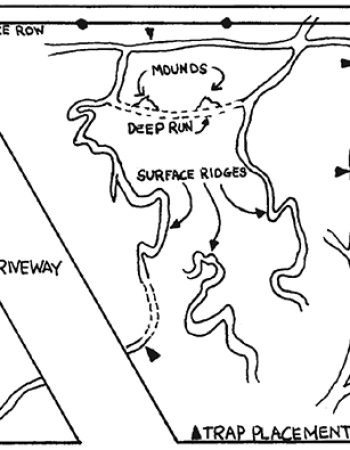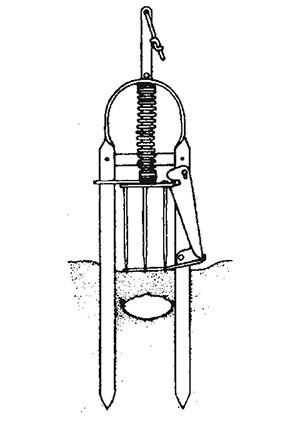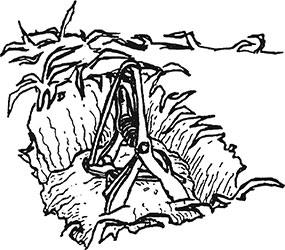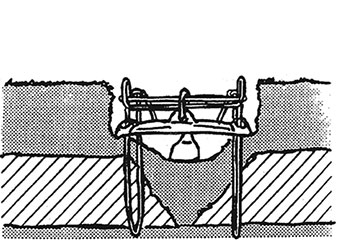Mole Management in Turf and Gardens
Moles are burrowing mammals that can cause problems in turf areas and garden plots while foraging for earthworms or insects in the soil. There are several mole species in North America, but this fact sheet is primarily based on biology and control of the eastern mole (Scalopus quaticus) which causes most of the mole related damage in the eastern United States. The starnosed mole (Condylura cristata) is also found in New Jersey and surrounding areas but rarely causes damage due to its preference for moist soil near water.
Mole Biology/Ecology
Symptoms
Moles push up unsightly mounds or ridges as they borrow through the soil in search of food. The tunneling activity dislodges plants and damages roots, and the mounds provide a medium for weed seed germination. While moles are often blamed for the destruction of bulbs, seeds, and garden plants, this damage is usually caused by various species of mice and voles that may inhabit or use mole tunnels. Moles rarely consume plant material.

Description
Moles belong to the family Talpidae in the order Insectivora (“insect-eaters”) and are thus related to shrews and hedgehogs. Eastern moles have a pointed snout with sharp, pointed teeth, small eyes, small ears concealed in the fur, a short, nearly hairless tail, and a velvety fur that varies from brownish to grayish with silver highlights. The large front feet with webbed toes and stout digging claws move laterally. Fully grown eastern moles measure 5″ to 8″ (13 to 20 cm) in length. The star-nosed mole can readily be identified by the fleshy tentacle-like projections on the tip of its nose.
Life history and habits
Eastern moles are found in pastures, meadows, woodlands, as well as lawns, cemeteries, parks, and golf courses. Their diet consists mainly of earthworms, white grubs, crickets, and other invertebrates that live in the soil. Rarely do they consume plant matter like a few weed seeds. They can consume 70 to 100% of their own body weight per day. Therefore, an acre of turf generally supports only 2 to 3 moles simultaneously.
Moles construct extensive burrow systems that consist of interconnected tunnels (runways) of two types: surface runways and deep runways. Certain runways of both types, but more commonly deep runways, are used as main avenues of travel; these main runways may be shared by several moles if their tunnel systems connect.
Surface runways appear as raised ridges running through turf areas. Moles are capable of extending surface runways at a rate of 100″ (30 m) per day. Surface runways may be used daily as main runways, but more commonly they are used as feeding burrows that are infrequently used or abandoned soon after being dug. Generally, few or no mounds are produced due to surface tunneling. Surface tunneling is greatest in spring and fall or after warm rains. During winter or dry summer periods moles move into deeper burrows because food becomes scarce near the surface.
Deep runways, which are usually main runways, are located 3″ to 12″ (30 to 45 cm) below the surface. They are used for daily travel between the nest and the surface runways. The only evidence for deep runways may be the molehills, volcano-like mounds of soil that the moles push up through short vertical tunnels when excavating deep runways. Deep runways are often constructed along the edge of sidewalks, driveways, fencerows, or other man-made borders, or around the woody perimeter of a yard.
Den and nest cavities, slight enlargements (6″ = 15 cm diameter) of the tunnels lined with vegetation, are built 12″ to 18″ below the surface and connect to main runways. They are located either in protected areas underneath boulders, trees, stumps, and fencerows, or randomly within the tunnel system in open field areas.
Moles live alone except during the short breeding period in late winter. A single litter of 3 to 5 hairless young is born 6 weeks later in the nest chamber. The young grow quickly and leave the nest to fend for themselves after only 6 weeks. Sexual maturity is reached the following year. The natural life span of moles is 3 to 4 years.
Control by trapping
Basics
Trapping is the most effective method for controlling moles. The key to success is knowledge of mole habits, patience, and persistence. Because lawns support only low numbers of moles and moles have a low reproductive rate, it is practical to eliminate them by trapping. Because the borrow system of a particular mole may extend over more than one lawn and/or the burrow systems of several moles may interconnect, neighbors may need to cooperate for successful control. Also be aware that turf areas surrounded by woodlots, pastures, or weedy fields may be reinfested continually because those areas can support large mole populations.
The design of mole traps is based on the moles’ habit of quickly repairing damaged runways. However, moles have an uncanny ability to detect and spring improperly set traps. If a mole encounters a foreign object in its runway, it will burrow around it. But if the trap is carefully concealed by soil blocking the runway, the mole will try to reopen the blockage. Avoid disturbing the burrow excessively when setting a trap.
When and where to trap
Spring and fall, when the moles are active near the soil surface, is the best time for trapping. Trapping in early spring will help prevent much of the damage, and it will also eliminate any pregnant females. For successful trapping it is essential to locate the main surface runways. Main runways are usually the ones that: (1) follow a more or less straight course for some distance, (2) connect two mounds or runway systems, (3) follow fence rows, concrete paths, or other manmade borders, or (4) run along the perimeter of lawns or fields. Because nests are usually located along the edge of areas, such as hedgerows or fence rows, border trapping at the places where runways enter the yard, field, or garden often provide good results, too.
To confirm if runways are active, tamp down a small section or poke small holes into them at several locations throughout the system. Mark the location and check if the moles repair them. If the damage in a given location is repaired within 1 or 2 days, place a trap near that spot. Unless mole activity is very light, multiple traps (3 to 5 per acre = 7 to 12 per hectare) will provide better and faster control. Ideally, traps
How to trap
Among the several types of traps available, the Victor® harpoon- or plunger type mole trap (Fig. 3) is probably the easiest to use, and is readily available from most hardware and garden stores, or from distributors. The trap uses sharp spikes to skewer the mole as it passes underneath.
Harpoon trap.
Fig. 3. Harpoon trap properly set on a surface runway (from Corrigan 1993).
To properly set a harpoon trap on a surface runway, carefully follow this procedure:
Measure the depth of the tunnel. If the bottom of the tunnel is deeper than the length of the spikes, remove a layer of soil so that the spikes will reach the bottom.
Using the side of your hand, lightly compress a section about 1″ (2.5 cm) wide of the ridge so that the tunnel is compressed to about half of its original diameter.
Center the traps (with safety catch in place) over the runway, and push the supporting legs into the soil until the trigger pan just touches the flattened area. Be sure the supporting legs do not cut into the tunnel below.
In hard soil, it may be helpful to form guide holes by raising and lowering the spears into the ground a few times. While doing this, hold the trap firmly in place to prevent the trap legs from riding up and down.
Set the trap and leave it, making sure not to step on any other portion of the runway system.
A plastic pail can be placed over the trap to discourage kids or pets from tampering with it.
Check the trap daily. If it fails to capture a mole within 3 to 4 days, move it to a different part of the main runway system.
After all the moles have been trapped, collapse and fill in all visible tunnels to discourage other moles from taking residence.
Two other types of traps are more difficult to use because they require partial excavation of a section of burrow. But they are less conspicuous to passers-by than the harpoon trap. The scissor-jaw trap and the choker (-loop) trap use spring-loaded scissor arms and loops, respectively, to capture moles (Fig. 4). To place traps, excavate a section of the burrow, replace soil loosely, set traps in the loosely replaced soil so that the choker trap’s loops encircle the burrow (at least 1″ below the original passage) or the scissor trap’s jaws straddle the burrow.
Do not use motor oil or WD-40 to lubricate traps. Remove rust and dirt with a wire brush, and lightly lubricate with mineral oil only.



Other Approaches to Mole Control
Direct removal
On days when moles can be expected to be active near the surface, flatten small sections of active runways and mark them with a thin wire flag placed on top of the compressed tunnel. When a flag is moving sneak up and insert the blade of a shovel behind the mole to prevent if from retreating in the open tunnel. The mole can be killed with a pitchfork or a hard stomp directly on top of it. Or it can be scooped out, placed in a pail, and released in a woodlot or weedy field somewhere distant.
Moles can also be live-trapped with pitfall traps (Fig. 5). Bury an empty 3 lb coffee can (or similar container) in the ground so that the top edge is level with the bottom of the mole tunnel. Then carefully cover the exposed can and tunnel with a board. The mole will get trapped in the can and can be disposed of in an appropriate area.
Mole barriers
Installation of a mole barrier should be considered when garden plots, seed beds, nurseries, or well-manicured turf areas are surrounded by large tracts of woods or weedy fields containing large mole populations. Barriers can be constructed from 3′ (91.5 cm) width of galvanized hardware cloth or aluminum sheathing. The barrier should be buried to a dept of 2′ (61 cm) (1.5′ in hard ground) with 6″ (15 cm) left exposed above the ground, and 3″ (7.5 cm) at the bottom bent outward to discourage moles from digging under. Mole barriers offer long-term protection but may be impractical in larger areas unless the problem is persistent and the damage justifies the time and expense of installation.
Reducing invertebrate prey
In general, grub control will not provide much long-term relief from moles because moles feed on earthworms and other soil invertebrates as well. Any potential benefits would not be evident for several weeks because the moles will be even more active trying to find food. If they indeed move out of the treated site, they will not move far and can reinvade the site even several years later after having reproduced.
Poison gases
Cartridge, tablet, or pellet-type fumigants generally don’t penetrate through the moles’ extensive runway system, or the fumigant is lost through the top of the surface runways. Any occasional success is at best temporary. Fumigation is relatively expensive and the benefits rarely justify the costs.
Poison baits
Poison peanuts or other baits are ineffective because moles eat insects and earthworms. The baits may be hazardous to pets or wildlife that dig up and consume them.
Repellents
It is doubtful that the so-called mole plant, Euphorbia lathyris, or castor bean plant repels moles. The plant is poisonous to children, and can easily become a weed. Castor oil and castor oil based products (e.g. Mole-Med®) are supposed to reduce mole activity when thoroughly watered into the lawn (at least 1″ of irrigation). But no scientific research has shown consistent results and these products also can cause environmental contamination.
Home remedies
Placing chewing gum in the burrows has no effect; moles don’t eat chewing gum. Flooding tunnels or directing automobile exhaust down the burrows is useless. Putting broken glass, razor blades, rose branches, bleach, diesel fuel, gasoline, lye, sheep dip, or human hair down the burrows pose greater hazards to the environment then to the moles. Frightening devices such as mole wheels (spinning daisies), vibrating windmills, and whistling bottles are ineffective.
Mention or display of a trademark, proprietary product, or firm in text or figures does not constitute an endorsement by Rutgers Cooperative Extension and does not imply approval to the exclusion of other suitable products or firms.
